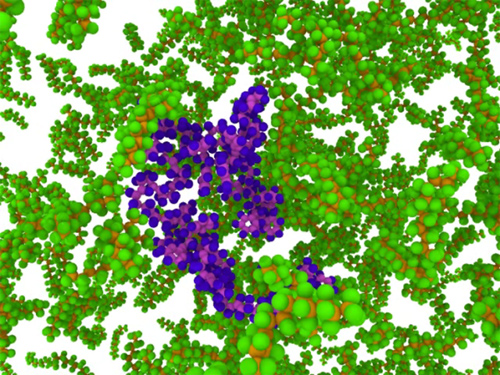
The image depicts a hydraulic fluid additive molecule.
In a recent blog, “A nanoscale view of hydraulic fluids,” we related how researchers at the University of California, Merced and the Milwaukee School of Engineering are working to better understand the fundamentals of hydraulics fluids on the molecular level, and how that might lead to more-efficient fluid-power systems.
A key tool in the research is molecular dynamics simulation, which can provide basic insights into material behavior.
Molecular dynamics simulation (MDS) is a mathematical modeling method for studying the structure and physical movements of atoms and molecules. It is typically applied in areas like materials science and biochemistry. This may be the first time the technique has been used in the fluid-power field.
As a bit of background, consider the more-familiar finite-element analysis method. FEA is micron-scale modeling, where the user defines small regions in a material and then describes how these tiny pieces of material respond to forces and other inputs based on empirical expressions. MDS can be considered an extremely small-scale version of FEA. Here, however, the fundamental equations that describe the nanoscale bits of material are based on atomic and molecular interactions.
The basics of the technique involve solving Newton’s equations of motion. Consider two atoms. When they are sufficiently far from one another, they don’t interact at all. As they start to approach, they might feel a slight attractive force, and when they get closer still they experience a repulsive force. This is the simplest concept of atoms interacting. MDS can model such interactions with simple (or not so simple) empirical expressions that describe the forces between two atoms as merely a function of the distance between them.
The method starts with the initial configuration of the material to be modeled—such as the basestock and additive molecules of a hydraulic fluid—and then the simulation predicts how that configuration changes over time.
Researchers need to describe how these atoms are positioned in space, relative to each other. Knowing where they are, and the distances between them, the software can calculate the forces on each atom in the system. From the force, it can calculate acceleration from F = MA, integrate that to get a velocity for each atom in the system, and then move each atom through a distance from the calculated velocity over a simulation time step.
Thus, the empirical expressions describe the forces, positions and motions on atoms and molecules as they interact over time. The empirical models are not new, but they are being applied to fluid-power systems for the first time. To accomplish that, the researchers first need to model the molecules of interest. Then the simulation runs and outputs the positions and forces on the atoms. So they have to post-process the raw data to calculate fluid-power-relevant properties like viscosity.
Small simulations with just a few thousand atoms and simple force/distance relationships (empirical models) can be run on a desktop. On the other hand, simulating thousands of long-chain molecules interacting via complex functions requires more-powerful hardware, such as a computer cluster, to get results in a reasonable amount of time.
The ultimate goal is to learn more about the fundamental behavior of fluids and additives on the molecular level, and how that relates to properties like viscosity and shear stability. Someday this may lead to more-efficient hydraulic fluids.
The post What is molecular dynamics simulation of hydraulic fluid? appeared first on Sealing & Contamination Control Tips.
Filed Under: Filtration/Contamination Control, Sealing & Contamination Control Tips